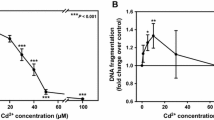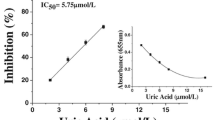Abstract
The cytotoxicity of hydroquinone (HQ) and several of its metabolites was studied using freshly isolated proximal tubular (PT) kidney cells from rats. Incubations were conducted for periods of up to 4 h at 37°C, with cytotoxicity measured either as increased leakage of lactate dehydrogenase or as a decreased energy status, as determined by decreased ratios of adenosine triphosphate (ATP) to adenosine diphosphate (ADP). Incubation atmospheres consisted of either 95% O2/5% CO2, to promote cell viability in vitro, or 5% O2/5% CO2/90% N2. Preliminary studies with bovine serum albumin (BSA) added to the incubation media indicated a lack of toxicity for HQ or its metabolites. For the tests discussed in this report, incubations were performed without the addition of BSA. Under 95% O2 atmospheres, PT cells from male Fischer F344 rats were significantly more sensitive to HQ than those from male Sprague-Dawley (SD) rats, with decreases in ATP to ADP ratios seen as early as 0.5 h at a concentration of 0.5 mM. When incubations were performed under a 5% O2 atmosphere, 2-(cysteine-S-yl)hydroquinone (Cys-HQ) and HQ toxicities were observed later (3–4 h) in the incubation period, occurred at higher concentrations, were similar in magnitude for the two strains, and were greater for Cys-HQ than for HQ. These results show that variations in oxygen tension can dramatically influence the toxicity of HQ and its metabolites. The specific compounds tested that were cytotoxic at a physiologically relevant oxygen tension (5%) were (in decreasing order of potency): Cys-HQ>2-(glutathion-S-yl)hydroquinone>HQ. These results support an association of toxicity with metabolism through the glutathione pathway, with ultimate toxicity associated with the cysteinyl conjugate. Biochemical characteristics of PT cells from these two strains suggest a significantly greater capacity of cells from the SD rat to respond to oxidative stress.







Similar content being viewed by others
References
Boatman RJ, English JC, Perry LG, Bialecki VE (1996) Differences in the nephrotoxicity of hydroquinone among Fischer 344 and Sprague-Dawley rats and B6C3F1 mice. J Toxicol Environ Health 47:159–172
Boogaard PJ, Mulder GJ, Nagelkerke JF (1989) Isolated proximal tubular cells from rat kidney as an in vitro model for studies on nephrotoxicity. Toxicol Appl Pharmacol 101:144–157
Colinas RJ, Burkart PT, Lawrence DA (1994) In vitro effects of hydroquinone, benzoquinone, and doxorubicin on mouse and human bone marrow cells at physiological oxygen partial pressures. Toxicol Appl Pharmacol 129:95–102
Corley RA, English JC, Hill TS, Fiorica LA, Morgott DA (2000) Development of a physiologically based pharmacokinetic model for hydroquinone. Toxicol Appl Pharmacol 165:163–174
Doepker CL, Dumont KW, O’Donoghue J, English JC (2000) Lack of induction of micronuclei in human peripheral blood lymphocytes treated with hydroquinone. Mutagenesis 15:479–487
English JC, Perry LG, Vlaovic M, Moyer C, O’Donoghue JL (1994) Measurement of cell proliferation in the kidneys of Fischer F344 and Sprague-Dawley rats after gavage administration of hydroquinone. Fund Appl Toxicol 23:397–406
Guder WG, Ross BD (1984) Enzyme distribution along the nephron. Kidney Int 26:101–111
Halliwell B (1988) Albumin: an important extracellular antioxidant. Biochem Pharmacol 37:569–571
Hard GC, Whysner J, English JC, Zang E, Williams GM (1997) Relationship of hydroquinone-associated rat renal tumors with spontaneous chronic progressive nephropathy. Toxicol Pathol 25:132–143
Hill BA, Davison KL, Dulik DM, Monks TJ, Lau SS (1994) Metabolism of 2-(glutathion-S-yl)hydroquinone and 2,3,5-(tri-glutathion-S-yl)hydroquinone in the in situ perfused rat kidney: relationship to nephrotoxicity. Toxicol Appl Pharmacol 129:121–132
Jones DP (1981) Determination of pyridine dinucleotides in cell extracts by high-performance liquid chromatography. J Chromatogr 225:446–449
Jones DP, Sundby GB, Ormstad K, Orrenius S (1979) Use of isolated kidney cells for study of drug metabolism. Biochem Pharmacol 28:929–935
Klos C, Koob M, Kramer C, Dekant W (1992) p-Aminophenol nephrotoxicity: biosynthesis of toxic glutathione conjugates. Toxicol Appl Pharmacol 115:98–106
Lash LH (1989) Isolated kidney cells in the study of chemical toxicity. In: McQueen CA (ed) In vitro toxicology: model systems and methods. The Telford Press, Caldwell pp 231–262
Lash LH (1990) Susceptibility to toxic injury in different nephron cell populations. Toxicol Lett 53:97–104
Lash LH, Tokarz JJ (1989) Isolation of two distinct populations of cells from rat kidney cortex and their use in the study of chemical-induced toxicity. Anal Biochem 182:271–279
Lash LH, Woods EB (1991) Cytotoxicity of alkylating agents in isolated rat kidney proximal tubular and distal tubular cells. Arch Biochem Biophys 286:46–56
Lau SS, Hill BA, Highet RJ, Monks TJ (1988) Sequential oxidation and glutathione addition to 1,4-benzoquinone: correlation of toxicity with increased glutathione substitution. Mol Pharmacol 34:829–836
Lowry OH, Rosebrough NJ, Farr AL, Randall RJ (1951) Protein measurement with the Folin phenol reagent. J Biol Chem 193:265–275
McDonald TA, Waidyanatha S, Rappaport SM (1993) Measurement of adducts of benzoquinone with hemoglobin and albumin. Carcinogenesis 14:1927–1932
National Toxicology Program (1989) Toxicology and carcinogenesis studies of hydroquinone in F344/N rats and B6C3F1 mice (gavage studies). NIH Publication 90-2821, Department of Health and Human Services, Washington, DC
Nerland DE, Pierce WM Jr (1990) Identification of N-acetyl-S-(2,5-dihydroxyphenyl)-L-cysteine as a urinary metabolite of benzene, phenol, and hydroquinone. Drug Metab and Dispos 18:958–961
Shao R, Tarloff JB (1996) Lack of correlation between p-aminophenol toxicity in vivo and in vitro in female Sprague-Dawley rats. Fund Appl Toxicol 31:268–278
Williams PD, Rush GF (1990) An evaluation of in vitro models for assessing nephrotoxicity. In: Anders MW, Dekant W (eds) Renal disposition and nephrotoxicity of xenobiotics. Elsevier Science Publishers, Amsterdam
Acknowledgements
This work was supported by the American Chemistry Council Hydroquinone Panel. We also gratefully acknowledge the assistance of Prof. Lawrence H. Lash. All experiments conducted were in compliance with the US Federal Animal Welfare Act.
Author information
Authors and Affiliations
Corresponding author
Rights and permissions
About this article
Cite this article
Boatman, R.J., English, J.C., Guerin, T.S. et al. The effect of oxygen tension on the cytotoxicity of hydroquinone and selected hydroquinone metabolites to isolated rat renal proximal tubular cells. Arch Toxicol 78, 443–452 (2004). https://doi.org/10.1007/s00204-004-0563-2
Received:
Accepted:
Published:
Issue Date:
DOI: https://doi.org/10.1007/s00204-004-0563-2




